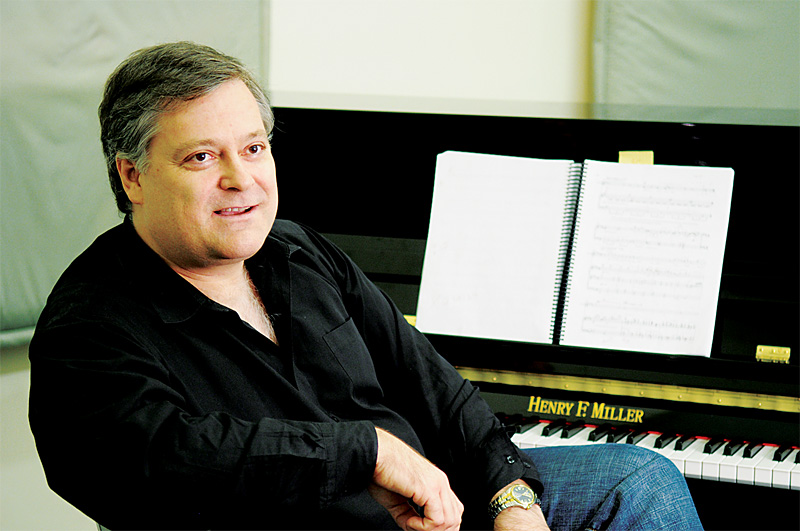In the final scene of Daron Hagen’s new opera Amelia, the heroine gives birth to a daughter. Hagen worked and reworked the scene—which starts with Amelia’s emergence from a coma and continues with her labor—struggling with the dramatic flow and an appropriate tone for his music. Two influences profoundly affected his end result. The first was watching the birth of his own son, which inspired him to make the scene “more realistic and more responsible,” as he puts it (removing a high note for the prone Amelia, for one thing). Second was Seattle Opera’s request for a three-minute interlude to enable a set change during the offstage birth itself, which prompted Hagen to further develop themes heard earlier in the opera and bring “musical closure” to his character’s emotional journey.
From such combinations of intense personal experience and bald practicality are operas born. When Seattle Opera premieres Amelia on May 8, it’ll be the culmination of years of work on the part of composer Hagen, librettist Gardner McFall, director Stephen Wadsworth, and the cast and crew. SO had not yet commissioned an opera under Speight Jenkins, general director since 1983. Intending to do so before his term at SO ends in 2013, Jenkins had Hagen on his short list, thanks to the composer’s 1993 Shining Brow, about Frank Lloyd Wright—acclaimed at its Madison, Wis., premiere, revived across the country, and recorded on the Naxos label. Specifically interested in a theme from recent American history, Jenkins was most captivated by Hagen’s pitch for Amelia, which combined the title character’s fixation on her pilot father’s death in the Vietnam War with metaphors of flight and the Icarus myth.
It took “a little over two years to write the vocal score, another six months to make revisions, and another six months to orchestrate it,” Hagen says in an interview from his home in New York City. The last bar of the score is dated April 24, 2009, but the piece is still evolving. After a summer 2008 workshop, Hagen says, “I made about a hundred small but meaningful changes to the vocal parts…in order to enhance understandability of the words.” He’s met with mezzo-soprano Kate Lindsey, who’s taking the title role, to hear her sing “four or five critical moments in the score that I want to know are absolutely clear textually and crafted specifically for her instrument.”
There are likely to be further changes once rehearsals begin the second week of April. A composer is “a little bit like a great tailor,” says tenor William Burden, who will play Amelia’s father, and who sang in the premiere of Tobias Picker’s 2005 An American Tragedy at the Met. “They make a suit from the measurements, then they put it on and make all the adjustments on the actual body. It’s a luxury to do a piece where the composer is actually there and can make adjustments to the vocal line to fit the voice, literally at the moment.” In older operas, Burden observes, “from Monteverdi on, it’s our responsibility to fit our instruments to their music. But in this kind of experience…we get to be part of the creation.”
Hagen describes McFall as the real “owner of this story.” She lost her own father in Vietnam—and adapted the text for one aria from her father’s words of farewell: “Pilots write ‘last letters,'” McFall says in an interview posted on SO’s Web site, “when they go out on sorties from which they might not return, and those letters are delivered to the family in the event of death.”
“It’s chilling to read it,” says SO costume-shop manager Susan Davis, displaying a three-inch-thick binder of research and sketches for Amelia put together by costume designer Ann Hould-Ward. It includes dozens of McFall’s personal photos. “We’re duplicating, essentially, Gardner’s father’s military history by putting the same medals on our character, as a way of honoring him…We’ve been using photos like this,” she says, pointing to a shot of the elder McFall in resplendent dress whites with JFK standing nearby. Also on Davis’ desk is a copy of The Naval Officers’ Uniform Guide, “to make sure we get the Navy research right…there are people in the audience who will know.”
Costume construction starts March 1, the Monday after SO’s upcoming show, Falstaff, opens. With no chorus, Amelia is a relatively small production; still, it’ll require about 90 costumes. For this modern-day story, says Davis, about a third of those can be bought off the rack. The visions of Daedalus and Icarus, however, require Greco-Roman toga-like robes: “Part of the magical element is that their fabrics have a metallic, shimmery, otherworldly quality,” Davis says.
In her eighth year with SO, Davis relishes her first opportunity to work on a premiere here, and like Burden looks forward to the creative freedom. “You don’t have to say ‘So what does Carmen usually wear?’ or ‘Tosca’s never in a blue dress.’ Anything can happen.”







